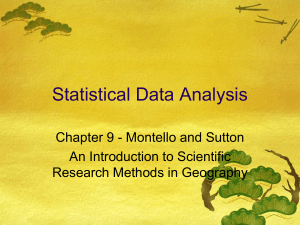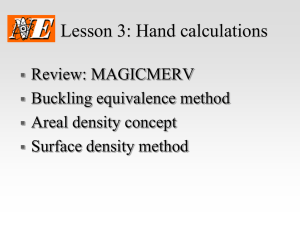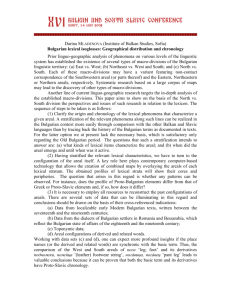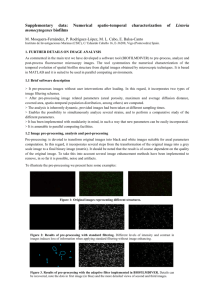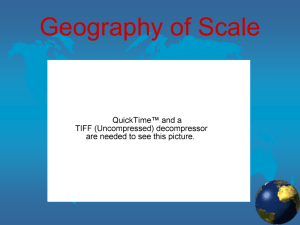TRACKING AREAL OBJECT IDENTITY IN SNAPSHOT SEQUENCES
advertisement
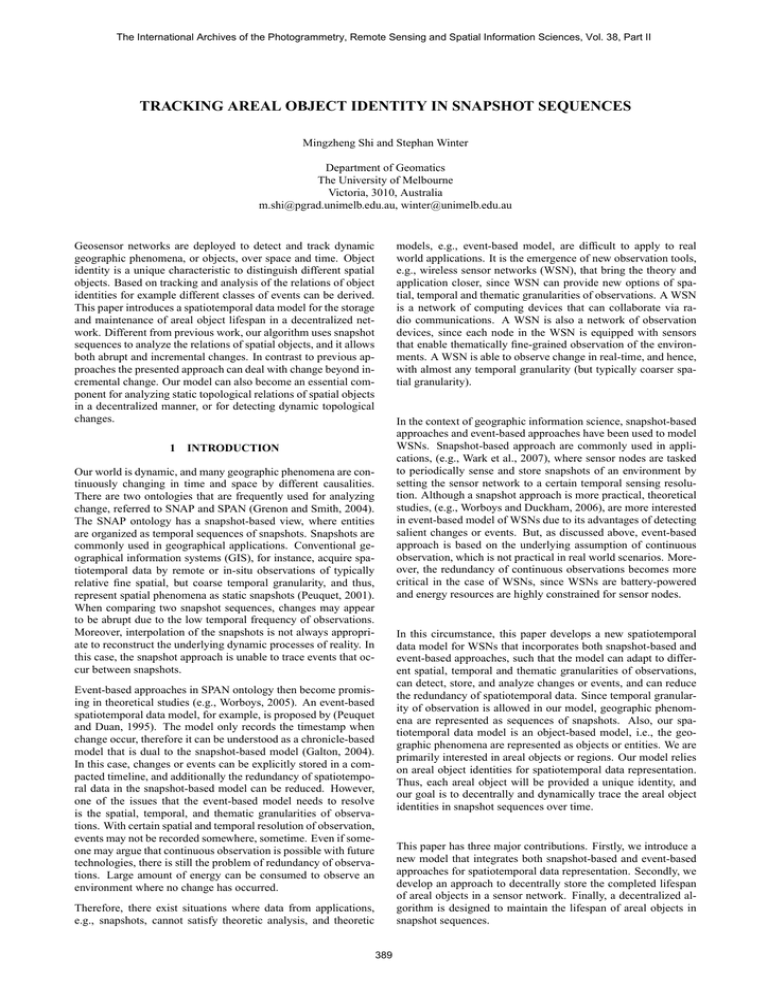
The International Archives of the Photogrammetry, Remote Sensing and Spatial Information Sciences, Vol. 38, Part II
TRACKING AREAL OBJECT IDENTITY IN SNAPSHOT SEQUENCES
Mingzheng Shi and Stephan Winter
Department of Geomatics
The University of Melbourne
Victoria, 3010, Australia
m.shi@pgrad.unimelb.edu.au, winter@unimelb.edu.au
models, e.g., event-based model, are difficult to apply to real
world applications. It is the emergence of new observation tools,
e.g., wireless sensor networks (WSN), that bring the theory and
application closer, since WSN can provide new options of spatial, temporal and thematic granularities of observations. A WSN
is a network of computing devices that can collaborate via radio communications. A WSN is also a network of observation
devices, since each node in the WSN is equipped with sensors
that enable thematically fine-grained observation of the environments. A WSN is able to observe change in real-time, and hence,
with almost any temporal granularity (but typically coarser spatial granularity).
Geosensor networks are deployed to detect and track dynamic
geographic phenomena, or objects, over space and time. Object
identity is a unique characteristic to distinguish different spatial
objects. Based on tracking and analysis of the relations of object
identities for example different classes of events can be derived.
This paper introduces a spatiotemporal data model for the storage
and maintenance of areal object lifespan in a decentralized network. Different from previous work, our algorithm uses snapshot
sequences to analyze the relations of spatial objects, and it allows
both abrupt and incremental changes. In contrast to previous approaches the presented approach can deal with change beyond incremental change. Our model can also become an essential component for analyzing static topological relations of spatial objects
in a decentralized manner, or for detecting dynamic topological
changes.
1
In the context of geographic information science, snapshot-based
approaches and event-based approaches have been used to model
WSNs. Snapshot-based approach are commonly used in applications, (e.g., Wark et al., 2007), where sensor nodes are tasked
to periodically sense and store snapshots of an environment by
setting the sensor network to a certain temporal sensing resolution. Although a snapshot approach is more practical, theoretical
studies, (e.g., Worboys and Duckham, 2006), are more interested
in event-based model of WSNs due to its advantages of detecting
salient changes or events. But, as discussed above, event-based
approach is based on the underlying assumption of continuous
observation, which is not practical in real world scenarios. Moreover, the redundancy of continuous observations becomes more
critical in the case of WSNs, since WSNs are battery-powered
and energy resources are highly constrained for sensor nodes.
INTRODUCTION
Our world is dynamic, and many geographic phenomena are continuously changing in time and space by different causalities.
There are two ontologies that are frequently used for analyzing
change, referred to SNAP and SPAN (Grenon and Smith, 2004).
The SNAP ontology has a snapshot-based view, where entities
are organized as temporal sequences of snapshots. Snapshots are
commonly used in geographical applications. Conventional geographical information systems (GIS), for instance, acquire spatiotemporal data by remote or in-situ observations of typically
relative fine spatial, but coarse temporal granularity, and thus,
represent spatial phenomena as static snapshots (Peuquet, 2001).
When comparing two snapshot sequences, changes may appear
to be abrupt due to the low temporal frequency of observations.
Moreover, interpolation of the snapshots is not always appropriate to reconstruct the underlying dynamic processes of reality. In
this case, the snapshot approach is unable to trace events that occur between snapshots.
In this circumstance, this paper develops a new spatiotemporal
data model for WSNs that incorporates both snapshot-based and
event-based approaches, such that the model can adapt to different spatial, temporal and thematic granularities of observations,
can detect, store, and analyze changes or events, and can reduce
the redundancy of spatiotemporal data. Since temporal granularity of observation is allowed in our model, geographic phenomena are represented as sequences of snapshots. Also, our spatiotemporal data model is an object-based model, i.e., the geographic phenomena are represented as objects or entities. We are
primarily interested in areal objects or regions. Our model relies
on areal object identities for spatiotemporal data representation.
Thus, each areal object will be provided a unique identity, and
our goal is to decentrally and dynamically trace the areal object
identities in snapshot sequences over time.
Event-based approaches in SPAN ontology then become promising in theoretical studies (e.g., Worboys, 2005). An event-based
spatiotemporal data model, for example, is proposed by (Peuquet
and Duan, 1995). The model only records the timestamp when
change occur, therefore it can be understood as a chronicle-based
model that is dual to the snapshot-based model (Galton, 2004).
In this case, changes or events can be explicitly stored in a compacted timeline, and additionally the redundancy of spatiotemporal data in the snapshot-based model can be reduced. However,
one of the issues that the event-based model needs to resolve
is the spatial, temporal, and thematic granularities of observations. With certain spatial and temporal resolution of observation,
events may not be recorded somewhere, sometime. Even if someone may argue that continuous observation is possible with future
technologies, there is still the problem of redundancy of observations. Large amount of energy can be consumed to observe an
environment where no change has occurred.
This paper has three major contributions. Firstly, we introduce a
new model that integrates both snapshot-based and event-based
approaches for spatiotemporal data representation. Secondly, we
develop an approach to decentrally store the completed lifespan
of areal objects in a sensor network. Finally, a decentralized algorithm is designed to maintain the lifespan of areal objects in
snapshot sequences.
Therefore, there exist situations where data from applications,
e.g., snapshots, cannot satisfy theoretic analysis, and theoretic
389
The International Archives of the Photogrammetry, Remote Sensing and Spatial Information Sciences, Vol. 38, Part II
2
3
RELATED WORK
SPATIOTEMPORAL DATA REPRESENTATION
For geographic data representation, there is a distinction between
field-based and object-based models. Our spatiotemporal data
model is an object-based model, and we use an object-oriented
approach to implement our model. In our approach, a WSN is
modeled as a set of point objects with point observations. An
appropriate data structure is essential for efficient interaction or
communication among point objects. The primary structure in
our model is an edge. Edges are important components for spatial objects. For example, an area is embedded in a polygon that
is constituted as a sequence of edges. By sensor network point
observations, geographic phenomena will be abstracted as areal
objects that consist of points, and these points will then be organized as sequence of edges.
Geographic phenomena may continuously change over time their
location, size, orientation, or their character. The change investigated in this paper is the change of spatial entities. A change occurs whenever spatial entities possess different spatial attributes
at different times (Galton, 2000). Grenon and Smith (2004) classify entities in the spatiotemporal world into two categories: one
is continuants, and the other is occurrents. The study of this paper
is on the perspective of continuants that exist at a given time at a
given level of granularity and undergo different types of changes
over time.
Hornsby and Egenhofer (1997) suggest a qualitative representation of change. Their notion of change is based on object identity, and a set of operations that either preserve or change identity.
This paper applies their concept of identity in sensor networks for
decentralized maintenance of areal object identities. Stell (2003)
starts from a partially ordered time scale and dynamic objects
with four fundamental operations on these objects (birth, death,
merge and split), similar to Hornsby and Egenhofer (1997). He
then introduces granularity of objects by two further operations,
amalgamation and selection. This means his concept of granularity is based on sets. In contrast, the granularities discussed in this
paper are related to observations. A discussion of spatiotemporal
data model can be found in Abraham and Roddick (1999).
Figure 1 illustrates an example about the representation of dynamic areal objects in a sensor network. Suppose Figure 1(a)-(d)
are at four different time steps, e.g., t1 , t2 , t3 , and t4 . Between
t1 and t2 , two polygons expand. Between t2 and t3 , the two
polygons merge into a larger polygon. And the larger polygon
expands again between t3 and t4 . If the temporal granularity
of observation is fine enough to acquire all the four snapshots,
then we can infer three changes or events, i.e., expand, merge,
and expand, between the four snapshots respectively. If the given
temporal granularity can only acquire two snapshots at t1 and
t4 in Figure 1(a) and (d), then only one event, i.e., merge, can
be inferred between the two snapshots. These changes between
snapshots may include incremental changes, but there are also
non-incremental changes, for example, the change between Figure 1 (c) and (d). By allowing granularity of observations in our
model, we should also allow granularity of changes.
As discussed in Section 1, decentralized approaches in WSNs can
be classified into snapshot-based approaches and event-based approaches. Lian et al. (2007) propose a gradient boundary detection approach, where snapshots of a monitored region are transmitted to a designated central computer via the sink of the network at certain time intervals. A snapshot at a given time t is
abstracted as a contour map, which consists of gradient boundaries. Only the nodes on the gradient boundaries need to report
to the sink, which constructs a contour map. A unique work
for collecting snapshot data is proposed by Skraba et al. (2006).
Their method is called a sweep, i.e., a wavefront that traverses
the whole network and passes all nodes in the network exactly
once. Sarkar et al. (2008) apply the sweep method to construct
iso-contours in a continuous scalar field. Given the constructed
iso-contours of a snapshot, users can acquire contours at given
values or ranges. All the above approaches are limited to static
snapshots. They cannot dynamically analyze snapshot sequences
to derive salient changes.
(a)
(b)
(c)
(d)
Figure 1: The evolving of spatial objects over time. (a)-(d) are at
different time steps, e.g., t1 , t2 , t3 , and t4 .
There are always tradeoffs between granularity of observations
and granularity of spatiotemporal data. If a finer granularity of
observation is applied to a sensor network, more energy will be
consumed for observation, communication, and data processing
in the network, but the acquired data would have higher quality.
On the other hand, coarser granularity of observation means less
energy consumption and lower data quality. Our model can be
applied to different granularity of observations. Note that there
is limited number of point observations in a sensor network deployed area, which means spatial granularity of observation has
a limit. Even the finest temporal and thematic granularity of observations are applied, inaccuracy and imprecision will be always
associated with the observed spatiotemporal data. In this paper,
we assume a certain granularity of observations can be decided
for an application, so that the energy consumption and the accuracy of spatiotemporal data can be balanced.
Duckham et al. (2005) develops a model to track salient changes
or events in the environment. They model a sensor network as
a triangulation network. And the triangulation can change over
time in response to the movement of spatial phenomena. Worboys and Duckham (2006) also use triangulations, and spatial
objects is represented as a set of triangles. Changes of spatial
objects are represented as the insertion or deletion of triangles
from the set. However, their approach is limited to incremental changes, i.e., the change of a single triangle at each time
step. In contrast, our approach allows both abrupt and incremental changes. Sadeq and Duckham (2008) investigate different sensor network structures for detecting topological events. The fundamental topological events include appearance, disappearance,
merge and split, etc. Their approach also assume incremental
changes. Their classification of events is based on the theoretical study of Jiang and Worboys (2009). Although there are a
large amount of existing work on sensor network data models,
this paper is the first work to investigate areal object lifespans in
snapshot sequences.
This paper will focus on decentralized tracking of dynamic areal
objects in a sensor network under certain temporal granularity of
observations, as the example in Figure 1. Since temporal granularity of observation is taken into consideration, a sequence of
snapshots will be acquired by sensor networks. Each snapshot in
the sequence will contain a set of areal objects. By the evolution
390
The International Archives of the Photogrammetry, Remote Sensing and Spatial Information Sciences, Vol. 38, Part II
of areal objects over time, such as expansion, contraction, split,
and merge, edges of areal objects could remain unchanged, or be
inserted or deleted. The insertion and deletion of edges are important for our data model. In the rest of this section, we will
define the representation of inserted and deleted edges in a sensor
network.
Areal objects are represented as sequence of boundary edges in
the network. An example is shown in Figure 2(b), in which the
nodes v, a, b, c, d and e are located in an areal object. The edges
(a, b), (b, c), (c, d), (d, e), (e, a) are boundary edges, since they
do not belong to any object cycles.
Since areal objects are evolving over time, sequences of boundary
edges would dynamically change at different snapshots, as illustrated in Figure 3. The difference of boundary edges between two
consecutive snapshots is represented by the insertion and deletion
of boundary edges. If a boundary edge appears between ti−1 and
ti , then we will insert the boundary edge into relevant datasets
with a timestamp of ti , and vise versa. Each sensor node in the
network may be involved in the insertion and deletion of boundary edges in its own datasets. To represent the change of areal
objects in a sensor network, we require two definitions:
Firstly, a sensor network can be modeled as a directed planar
graph G = (V, E), which is built by Delaunay triangulation
(Preparata and Shamos, 1985). In the graph G, V is a set of nodes
and E is a set of edges, e.g., (v, v ′ ), which represent the direct
communication links between the nodes v ∈ V and v ′ ∈ V .
We assume that E is symmetric, i.e., if there are v, v ′ ∈ V ,
(v, v ′ ) ∈ E, then (v ′ , v) ∈ E. Note that the direction of a
directed edge will be illustrated in a figure when it is relevant,
otherwise the representation of G can be simplified as in Figure
2(a).
l
a
The set of neighbors of v ∈ V is denoted as neighbor(v) =
{v ′ : (v, v ′ ) ∈ E}. For example in Figure 2(a), neighbor(v) =
{a, b, c, d, e}, and the set neighbor(v) is sorted into clockwise
order. Our approach is a decentralized approach in the sense that
each point object only stores information about itself and its immediate neighbors. Each point object has its own datasets, and
global knowledge, e.g., the information about the whole network
G, is unavailable in point objects.
b
i
j
d
d
f
g
a
b
j
d
a
(a)
(b) t2
l
b
k
i
j
h
m
f
g (c) t
1
d
h
m
e
f
g
(d) t2
Figure 3: Examples of creation and deletion of edges. The created edges are denoted as thick continuous lines, and the deleted
edges are denoted as dashed lines. Areal objects are marked by
dashed-line ellipses. Note that the directions of edges are not
shown in the figure.
v
b
a
g
c
e
b
f
a
k
i
e
e
j
h
e
(a) t1
l
c
v
i
d
h
e
d
k
b
c
c
c
c
l
a
k
(b)
Figure 2: Sensor network structure. (a) An example of a communication graph G, where the set neighbor(v) of each node v
is sorted into clockwise order. (b) An areal object, illustrated as
an solid circle, is represented by a sequence of boundary edges
(a, b), (b, c), (c, d), (d, e), and (e, a).
Definition 5 A boundary edge (v, v ′ ) ∈ E is an inserted edge,
at time ti if the edge is not a boundary edge at previous time ti−1 ,
but become a boundary edge at time ti .
A node v and its neighbors are organized into directed cycles, or
simply cycles. A cycle is denoted as (v, b, a, v), where the three
nodes v, a and b are distinct, and there is an edge for any two
consecutive nodes in the cycle, i.e., (v, b), (b, a), (a, v) ∈ E. Examples of cycles can be found in Figure 2(b), where (v, b, a, v)
and (v, c, b, v) are cycles. Since neighbor(v) is in clockwise order, all the cycles are counterclockwise, and an example is shown
in Figure 2(b). Based on the above definition, we can define the
representation of areal objects in a sensor network:
Definition 6 A boundary edge (v, v ′ ) ∈ E is an deleted edge, at
time ti if the edge is a boundary edge at previous time ti−1 , but
is not a boundary edge at time ti .
The inserted and deleted edges will be decentrally stored at different sensor nodes in the network with a timestamp. Two local datasets, i.e., insertedEdge(v, t) and deletedEdge(v, t),
are required at each node v to store inserted and deleted edges
over time. For example, an area object is expanded from Figure
3(a) to (b), so that edges al, lk, kj, and jh have been inserted
and edges ai and ih have been deleted. And the other edges
remain unchanged. Six nodes a, i, h, j, k, and l need to record
the insertion and deletion of boundary edges. For example, there
are insertedEdge(a, t2 ) = {(a, l)} and deletedEdge(a, t2 ) =
{(a, i)} for the node a.
Definition 1 A directed edge (v, v ′ ) ∈ E is an object edge, if
both v and v ′ are located in an areal object.
Definition 2 A cycle (v, b, a, v) is an object cycle, if all the vertexes of the cycle, i.e., v, a, b, are located in an areal object.
4
AREAL OBJECT IDENTITY
Definition 3 An object edge (v, v ′ ) ∈ E is a non-boundary edge,
if the edge belongs to an object cycle.
4.1
Definition 4 An object edge (v, v ′ ) ∈ E is a boundary edge, if it
does not belong to any object cycles.
In our model, spatiotemporal data is decentrally stored in each
node in the network. These spatiotemporal data acquired at different time steps may need to be accessed for qualitative and
391
Leader and Trajectory
The International Archives of the Photogrammetry, Remote Sensing and Spatial Information Sciences, Vol. 38, Part II
quantitative analysis. For example, two consecutive snapshots
at time steps ti and ti−1 could be used to calculate the area difference of an areal object between two time steps. This section
introduces the concept of leader and trajectory, which will enable
the decentralized retrieval of historical spatiotemporal data.
the identity of the areal object. The identity of a trajectory will be
decentrally stored in each trajectory edge. For example, in Figure
5(a), node a is a leader and a trajectory identity, e.g., A, is given
to each edge on the trajectory. To correctly access each snapshot
of an areal object from the trajectory, each boundary edge of the
areal object at each snapshot should also have an identity. And
the identity of boundary edges should match the identity of the
trajectory. In Figure 5(a), each boundary edge of the areal object
is also provided the same identity A.
We define a leader of an areal object as a selected node that is
currently located inside the areal object. A leader trajectory, or
simply trajectory, is the path of the leader over time. A trajectory
consists of a sequence of edges, called trajectory edges. Since
areal objects are changing over time, the leaders and leader trajectories need to be dynamically updated. Figure 4(a)-(d) show
a general idea about the update of leaders and leader trajectories.
Assume that there is no areal object at initial time step t0 . Between time step t0 and t1 , an areal object appears. A node a on
the boundary edges of the areal object is selected as the leader.
The leader a reports the appearance of the areal object to the sink
by greedy routing (Karp and Kung, 2000). During the routing,
the information of the leader a will be recorded along the path
from a to the sink. We regard the path between the leader a and
the sink as one part of the leader trajectory.
The identity A will be used to identify the trajectory over time.
Thus, when the areal object changes over time, the same identity
should be maintained. In Figure 5(b), the areal object has contracted at t2 , and the leader is changed from a to b. The same
identity A should be updated for both new trajectory edges and
new boundary edges, as shown in Figure 5(b).
A
A
A
A
A
A
A
A
a
A
A
A
b
(b) t2
a
c
(c) t3
a
c
(d) t4
Figure 4: Leaders and leader trajectories need to be updated when
areal object changes over time. Leaders are marked by circles,
and dashed lines represent the leader trajectories.
4.3
A
A
A
A
A
(b) t2
Trajectory Maintenance
There are six types of changes of areal objects that require possible updates of trajectories. These six types of changes are:
appearance, disappearance, expansion, contraction, merge, and
split. When an areal object appears, a new trajectory needs to
be created for the areal object, and the trajectory needs a unique
identity. Figure 6 has a abstract representation of the changes of
trajectories. In the figure, the star represents the sink, circles or
nodes represent leaders, and a continuous line represents a path
between two nodes. In Figure 6(a)-(b), an areal object appears, a
leader is selected, and an identity of A is given to the leader. Also
the path between the leader and the sink has the same identity A.
An areal object with a trajectory identity A will be simply called
areal object A.
As in Figure 4 (a) and (b), the areal object contracts between t1
and t2 , and the leader a is not longer in the areal object. The node
b is then selected as the new leader, and the path between the two
leaders a and b is added into the leader trajectory. Similarly, at
t3 in Figure 4(c), there is an update of the trajectory between
leader b and c. Finally, between t3 and t4 , the areal object disappears. The leader c will report the disappearance of the areal
object to the sink. And at the same time, the nodes along the path
between c and the sink will record the trajectory. A completed
trajectory that enables the access of the full history of the areal
object is then formed at the sink. The completed trajectory is a
closed traversable trail, as shown in Figure 4(d). The leader trajectory can be considered as a chronicle that links all the relevant
snapshots of an areal object.
4.2
A
As discussed in Section 3, each boundary edge of areal objects
has a timestamp. For instance, the boundary edges in Figure 5 (a)
and (b) are associated with a timestamp of t1 and t2 respectively.
The snapshot sequences of areal objects can be easily retrieved
using trajectory and its identities. For example, if a query inserted from the sink is interested in the areal objects at t2 , then
the relevant data can be retrieved by a traversal from the sink to
the leader b. And the leader b (with identity A) can then traverse
all the boundary edges that have a timestamp of t2 and have the
identity of A. Before the trajectories can be used for accessing
spatiotemporal data in a decentralized network, we firstly need to
maintain the trajectory identities when areal objects change over
time.
b
b
A
A
b
Figure 5: Trajectory Identity. Boundary edges of the areal object
have the same identity as the trajectory edges.
a
(a) t1
a
A
(a) t1
a
A
As discussed in the previous section, when an areal object expands or contracts, the trajectory of the areal object may need to
be updated. In Figure 6(c), a new leader is selected for the trajectory A due to the expansion of the areal object, and there is a
path between the two leaders. Between t2 and t3 , areal object A
contracts and a new areal object B appears, and their trajectories
are updated correspondingly.
Trajectory Identity
To correctly access spatiotemporal data of areal objects, each
leader trajectory should have an identity. Since each areal object has only one trajectory, the trajectory identity is also used as
392
The International Archives of the Photogrammetry, Remote Sensing and Spatial Information Sciences, Vol. 38, Part II
A
appear
A
(a) t0
expand
A
A
A
B
A
A
A
A
A
A
B
B
contract
appear
A
B
B
expand
A split
A
B
A
B
A
B
A
A
A
A
A
A
B
(d) t3
A
A
A
A
A
A
B
B
(e) t4
contract
disappear
A
A
(c) t2
(b) t1
merge
A
A
B C A
A
A
A
C
A
C
(f ) t5 , t6
A
B
A
B C A A A A A
A
A
A
C
C
C
C C
(g) t7 , t8
Figure 6: The trajectories need to be updated when areal objects change over time. The star represents the sink, different circles or
nodes at one time step represent different leaders, and a continuous line represent a path between two nodes. There may be multiple
stars at one time step, but these stars represent the same sink at a single location.
If two areal objects A and B merge, the two trajectories of the
areal objects have to merge into one trajectory, as in Figure 6(e).
One identity, e.g., A, can remain for the merged trajectory, and
the other trajectory B is concluded to the sink. With the conclusion of trajectory B, the sink will also aware the merge of two
areal objects A and B. In contrast, if an areal object A splits into
two areal objects, the trajectory A has to split into two trajectories, e.g., A and C, as shown in Figure 6(f). In Figure 6(g), both
areal objects A and C has disappeared, and both trajectories A
and C conclude to the sink.
d
d
c
c
A
expand
v
A
v
e
A
e
b
b
A
s
s
a
a
(a) t1
d
5
DECENTRALIZED ALGORITHMS
c
A
A
Since our algorithms are run decentrally in each sensor node in
the network. The algorithm for updating trajectory identity will
be dependant on different types of nodes in the network. We
assume that each sensor node has only binary readings, i.e., 0 and
1. If a sensor node is located inside an areal object, its reading is
1, otherwise the reading would be 0. We define that a node is an
active node if it changes readings between two consecutive time
steps. We use the set active(t) to represent all active nodes at the
time step t.
d
A
c
contract
v
v
e
s
e
A
b
A
a
(b) t2
b
s
(c) t1
a
(d) t2
Figure 7: Expansion and contraction. Leaders are marked by
circles, and transition edges are marked by dashed-line ellipses.
As discussed in Section 4.3, trajectories need to be updated differently when areal objects undergo different types of changes over
time. Our decentralized algorithms should firstly distinguish different types of changes, so that trajectories can be update properly. A large number of nodes may be involved in the changes
of areal objects, and thus in-network aggregations among relevant nodes are necessary. In our algorithm, graph traversals are
used to organize the aggregation of decentralized spatiotemporal
data. If all the relevant nodes initialize traversals in the network,
there would be a large number of redundant traversals, and the
efficiency of the algorithm will be significantly reduced. In this
case, only a small subset of sensor nodes is eligible to initialize
traversals.
In Figure 7 (a) and (b), for instance, an areal object expands from
t1 to t2 , and there are inserted edges (c, d), (d, e), and (e, a),
deleted edges (c, v) and (v, a), and active nodes d and e. We
define another type of edges:
Definition 7 An inserted or deleted edge is a transition edge if
the edge connects an active node and a non-active node.
For example, in Figure 7(b), the inserted edge (c, d) is a transition
edge that has a initial node c ∈
/ active(t2 ) and a terminal node
d ∈ active(t2 ). Also (e, a) is a transition edge, but the edge
begins at an active node e and ends at a non-active node a.
In the algorithm, only the node v that has transition edges, i.e.,
transitionEdge(v, t) 6= ∅, will be eligible for starting traversals. And the traversals will always start at non-active nodes.
For example, in Figure 7(b), {a, c} ∈
/ active(t2 ) and {d, e} ∈
active(t2 ), so the traversal would start from non-active nodes
a or c. Since node c is the initial node of the transition edge
(c, d), node c will start a traversal to visit all inserted edges, i.e.,
c → d → e → a, and reach another non-active node a. Node
a will then notice that c and a have the same identity A, and the
Transition edges are always in pairs. If there is a transition edge
with an initial non-active node and a terminal active node, then
there always exists another transition edge with an initial active
node and a terminal non-active node. A pair of transition edges
is always connected by a trial. For example, (c, d) and (e, a)
are connected by the trial c → d → e → a. The set of transition edges of a node v is denoted as transitionEdge(v, t), for
instance, transitionEdge(c, t2 ) = {(c, d)} in Figure 7(b).
393
The International Archives of the Photogrammetry, Remote Sensing and Spatial Information Sciences, Vol. 38, Part II
traversal has visited three inserted edges (c, d), (d, e), and (e, a).
An expansion of the areal object A is detected at node a. Similarly, in Figure 7(d), the non-active node c will start a traversal to
visit all deleted edges: c → d → e → a. And node a will detect
a contraction of areal object A.
d
h
A
c
B
v
B
b
s
A
c
l
a
g
A
b
A
A
e
A
Karp, B. and Kung, H., 2000. Gpsr: Greedy perimeter stateless
routing for wireless networks. In: MobiCom 00: Proceedings
of the 6th Annual International Conference on Mobile Computing and Networking, ACM Press, New York, NY, USA,
p. 243254.
k
c
split
v
l
s
Jiang, J. and Worboys, M., 2009. Event-based topology for dynamic planar areal objects. International Journal of Geographical Information Systems 23(1), pp. 33–60.
(b) t2
h
A
v
e
d
k
A
A
Hornsby, K. and Egenhofer, M., 1997. Qualitative representation
of change. In: S. Hirtle and A. Frank (eds), COSIT 1997,
Volume 1329 of Lecture Notes in Computer Science, Springer,
Heidelberg, pp. 15–33.
k
b
(a) t1
d
h
v
l
Grenon, P. and Smith, B., 2004. Snap and span: Towards dynamic spatial ontology. Spatial Cognition and Computation
4(1), pp. 69–104.
c
merge
s
a
g
h
B
e
A
A
d
k
Galton, A., 2004. Fields and objects in space, time, and spacetime. Spatial Cognition and Computation 4(1), pp. 39–67.
e
l
b
s
(a) t1
g
a
Lian, J., Chen, L., Naik, K., Liu, Y. and Agnew, G., 2007. Gradient boundary detection for time series snapshot construction
in sensor networks. IEEE Transactions on Parallel and Distributed Systems 18(10), pp. 1462–1475.
(b) t2
Figure 8: merge and split.
Peuquet, D., 2001. Making space for time: Issues in space-time
data representation. Geoinformatica 5(1), pp. 11–32.
In Figure 8(b), two areal objects A and B have merged. There
are two active nodes d and v and four transition edges (c, d),
(d, k), (e, v), and (v, b). Both node c and e are eligible for starting traversals, since {c, e} ∈
/ active(t2 ) and they are initial nodes
of transition edges. The traversal starts from c will traverse inserted edges (c, d) and (d, k) and reach another non-active node
k: c → d → k. The other traversal from e is e → v → b. Node
k will notice c and k have different identities, and the traversal
has visited inserted edges. Thus, a merge of two areal objects is
detected at node k. Note that b can also detect the merge of two
areal objects. In Figure 8(c) and (d), an areal object splits into two
areal objects. Similarly, splits can also be detected by traversals.
6
Peuquet, D. and Duan, N., 1995. An event-based spatiotemporal
data model (estdm) for temporal analysis of geographical data.
International Journal of Geographical Information Systems 9,
pp. 7–24.
Preparata, F. and Shamos, M., 1985. Computational Geometry:
An Introduction. Springer, New York.
Sadeq, M. and Duckham, M., 2008. Effect of neighborhood on
in-network processing in sensor networks. In: T. C. et al. (ed.),
GIScience 2008, LNCS, volume 5266, Springer, Heidelberg,
pp. 133–150.
Sarkar, R., Zhu, X., Gao, J., Guibas, L. and Mitchell, J., 2008.
Iso-contour queries and gradient descent with guaranteed delivery in sensor networks. In: Proceedings of the 27th Conference on Computer Communications, IEEE, pp. 960–967.
CONCLUSION
This paper has introduced a new spatiotemporal data model that
enables the storage of areal object lifespan in snapshot sequences.
Each areal object has a unique trajectory that links all the relevant snapshots of the areal object together. The evolving of trajectories is dependent on the changes of areal objects. By the
maintenance of trajectories in a decentralized network, different
types of salient changes or events can also be derived by decentralized processing of snapshot sequences. An important area of
future work is to use the areal object trajectories for qualitative
and quantitative analysis of a static snapshot or dynamic snapshot sequences.
Skraba, P., Fang, Q., Nguyen, A. and Guibas, L., 2006. Sweeps
over wireless sensor networks. In: IPSN 06: Proceedings of
the 5th international conference on Information processing in
sensor networks, p. 143151.
Stell, J., 2003. Granularity in change over time. In: M. Duckham, M. Worboys and M. Goodchild (eds), Foundations in
Geographic Information Science, Taylor & Francis, London,
pp. 95–115.
Wark, T., Corke, P., Sikka, P., Klingbeil, L., Guo, Y., Crossman, C., Valencia, P., Swain, D. and Bishop-Hurley, G., 2007.
Transforming agriculture through pervasive wireless sensor
networks. IEEE Pervasive Computing 6(2), pp. 50–57.
References
Abraham, T. and Roddick, J., 1999. Survey of spatio-temporal
databases. Geoinformatica 3(1), pp. 61–99.
Worboys, M., 2005. Event-oriented approaches to geographic
phenomena. International Journal of Geographical Information Systems 19(1), pp. 128.
Duckham, M., Nittel, S. and Worboys, M., 2005. Monitoring
dynamic spatial fields using responsive geosensor networks.
In: Proceedings of 13th Annual ACM International Workshop
on Geographic Information Systems (GIS05), pp. 51–60.
Worboys, M. and Duckham, M., 2006. Monitoring qualitative spatiotemporal change for geosensor networks. International Journal of Geographical Information Systems 20(10),
pp. 1087–1108.
Galton, A., 2000. Qualitative Spatial Change. Oxford University
Press.
394
